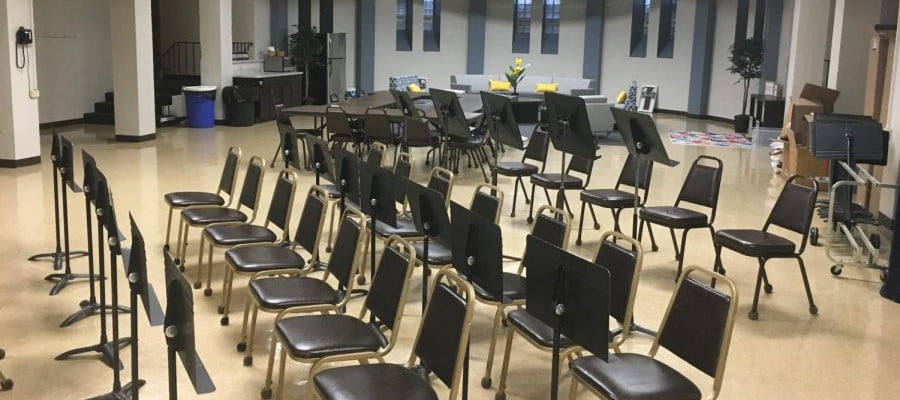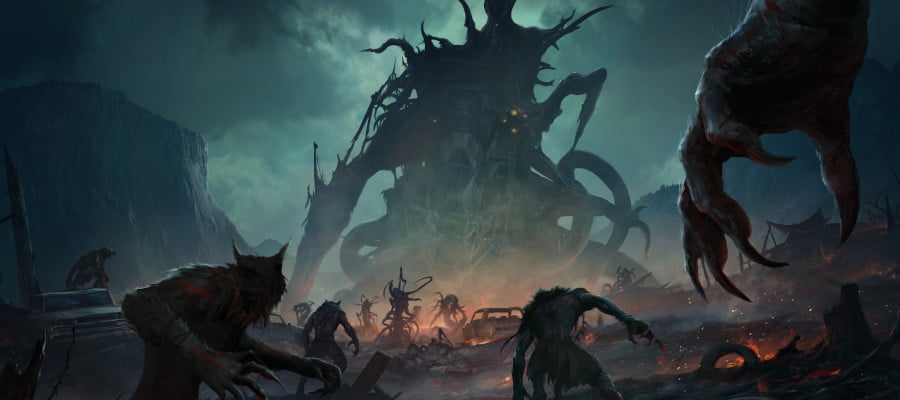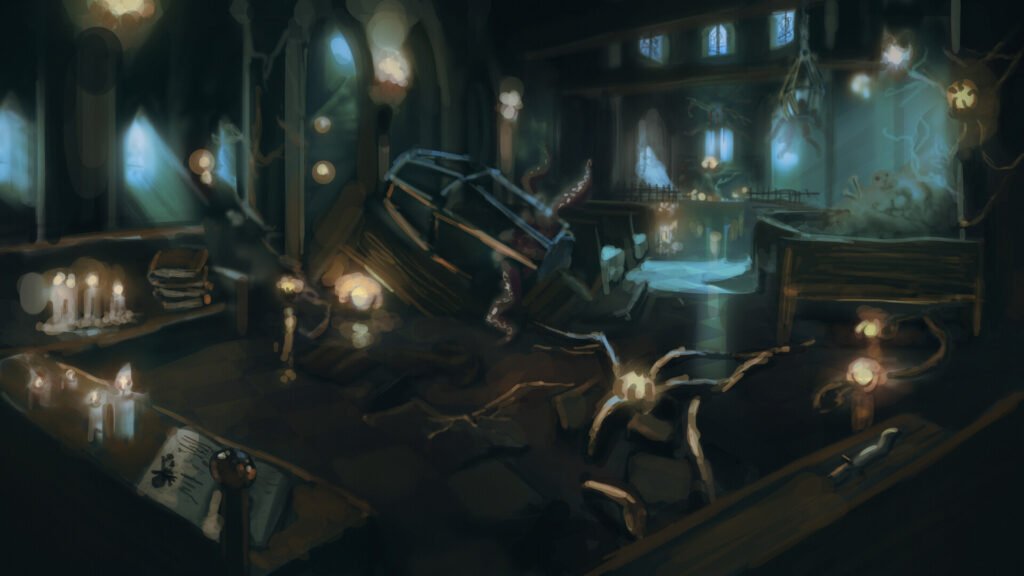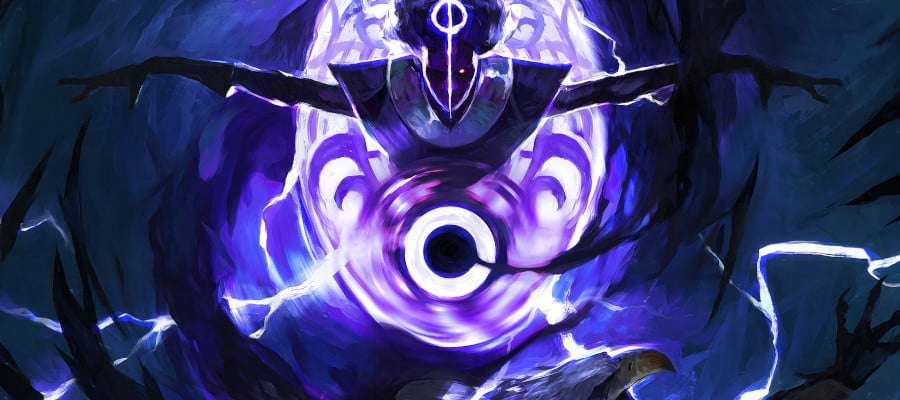In the maps of Cobrin’Seil, up and on the right someplace, there’s a place called Kryphaneos. Setting aside that that name is very close to The Kingdom Of Mal-Bad, Kryphaneos is definitely one of the signs of an unrefined worldbuilder’s ‘that’ll do.’ Kryphaneos was my all-purpose place for horror stuff, dark magic came from there, there was an ostensible kingdom with supposed capitals and places and purposes and that was all a thing but it was a thing that happened over there. Kryphaneos was very much a ripoff of Ravenloft, as written by someone who didn’t read any Ravenloft books — a kingdom of nothing but dark horror, divided up by foggy lines, where the most notable detail ever provided about it was that nobody wanted to be there.
As time goes on and I keep trying to refine these ideas I meant to write down someday, I figured it was time to confront this space of grim and dark horror, and write down what I wanted it to be. But this isn’t that, this isn’t a writeup of the place, as much as it is instead, a consideration of what I want that place for. What do I want to have in this part of the world, and why do I want it to be different to just any old existing space.
Basically, if I have an Evil Country, why do I have it? What’s it for? And why is it there, and most of all, does answering those questions make my world a place that sucks to exist in?
Okay first up let’s talk about the most important things about this place, specifically, what does it give me for players to use. This includes places for enemies to come from and threats to be built, for things that can be set in these places, like tall crumbling towers of precariously balanced terrible decisions, or lumbering dreadful leviathans that stir restlessly in lobotomised sleep, but also, what about people being from these places? What cultural windows am I opening up for players, and therefore, what kinds of things do I want to give my players access to in easily handled, clearly recognised ways?
First up: This place is a place of horror. The central theme of all of this place is going to be some element of horror. That means looking at what I mean by horror, what do I want my horror stuff in this space to look like or feel like. What are horrible heroes going to want as their building blocks and their aesthetics. I promise this is not predicated by reading a book about necromantic empires, I was doing this well beforehand. I promise.
The most immediate references I can think to for horror narrative stuff is:
- The videogames Bloodborne and Dishonored
- The Innistrad setting from Magic: The Gathering
- The works of HP Lovecraft and his connected spaces
- Evangelical Christian and Catholic aesthetics
- Arthur Machen’s The Great God Pan
- Terry Pratchett’s writing about the Fair Folk and elves in Lords & Ladies
- Tamsyn Muir’s Locked Tomb series
These are all things with a lot of overlap, and I think I am okay with that. There’s an impulse to try and use horror settings efficiently — especially when you look at dudes like Lovecraft and Machen, where both of them derived their horror from the foreign. But I don’t want to try and overstuff this one location, and also, there’s just something about the idea of centralising too many cultures because of a common theme that rubs me wrong. This is not the only place I’m going to see horror setting elements; the fact that mummies exist doesn’t mean that this is the place that mummies come from, because I don’t want this one place to have like, ersatz Egypt mashed up against ersatz Transylvania. That’s not how I like cultures to feel adjacent to one another, so I do want there to be a centralising aesthetic for this place.
Like, it’s one thing to have German and French aesthetics near one another, but if one country’s got Greece, British, and Egyptian aesthetics just piled up on top of one another,
In my D&D setting of Cobrin’Seil I’ve talked about the bad maps and the way some countries exist in some sort of nebulous ‘over thereness’, a fact that I have largely managed to get by with players who are very nice and kind about not making fun of me. If it makes sense enough in-situ, it doesn’t matter. The whole reason to do this is because I find the exercise itself fun and the idea of creating a world as a tool for other people to play in is engaging. Players are nice and they can solve problems for you but it’s also nice if the world they’re engaging with feels whole and real and rewards their paying attention.
Okay, then, let’s dig into these inspirations, though because I have an idea forming here out of these places, and I want to draw on one of the elements that’s less obvious: the aesthetic of evangelical christianity and horror as associated with it.
When I was a child there was this thing called the Soviet Union, or the USSR, or sometimes Russkies. It was a brooding empire off in the distance and we loved it. We didn’t love it, I mean, like, we didn’t like it at all, but we loved what it let us do. It let us tell stories about an impossibly terrible place where people had to burn money to avoid freezing, where Christians were incredibly, incredibly oppressed and nobody even knew what a Bible looked like and the KGB would shoot you if they caught you praying. And hey, when you’re in a cult, that looks super legit.
Let’s be clear, there was definitely religious oppression in the Soviet Union, but Protestant Evangelicals liked to tell ourselves the problem was ‘Protestant Evangelicals aren’t a dominant religion’ and never mentioned synagogues or mosques. And we fictionalised that narrative, with a host of stories that basically copied adventure cool crime adventure narratives for invading the Soviet Union bringing them Christianity and Bibles.
The thing is, the Soviet Union had no voice of its own out in our space. They could broadcast all they wanted, but none of that reached us. We got more stories from Africa than we got from the Soviet Union, a section of land so large it was larger than the goddamn moon. This, this idea, the idea of controlled propoganda spaces, that’s the horrifying thing that the Soviet Union had (we said), which just happened to strongly resemble our own controlled propoganda spaces (which we didn’t call that).
Here’s the core idea of what I need. I need a place where there’s a material reason a whole near-continent of multiple different contrasting nations can have control over stories in a wide reaching way. Now this is not to plant down a bunch of countries that look like Soviet countries because… I don’t know much about those countries. I could do you a terrible accent? Maybe?
Here’s the thing that this place is going to be built around: A boundary line through which certain kinds of stories have a hard time passing. I use the idea of the fae and the fair folk as examples of a strange, detached kind of reality that is based on how things feel not on how things are – a vision of alien life unbound by material needs. It’s the origin of the elves and other problems, and doesn’t even relate to time the way everything else does. The result is a weird mix of storybook rules and material realities — they bind themselves to reality in ways that make sense to them, but can also break very easily.
We’re looking at a peninsula. Six is the important number of this peninsula, the number that things are broken into, the number that naturally makes sense, and the number that people are used to. When you hear about four knightly orders outside, you assume there’s something wrong with the report, and maybe imagine other orders that you just haven’t heard of. Enough time, those stories calcify and you become convinced of it, especially if you share your thoughts with another.
In this peninsula there are going to be the six great countries, and these countries are going to be varied in size and importance and their general vibes. The place has a gloomy air, long nights, and most places have a predatory, consumptive narrative focus, with things like Nobility and Capitalism metaphorised through things like vampires and the undead. And prior to recently, there was the Great Curtain.
The Great Curtain is not a hard barrier. You can walk across it. You might not even notice when you do. But on either side of the boundary, stories predate and poison stories from the other side. Real and true tales of what happens in this peninsula are slowly corrupted, the longer and further they are repeated outside it. The truths of the world outside peninsula are similarly distorted, meaning that neither side of the line has a realistic, reasonable view of what’s going on outside, and therefore, keep away from what is clearly a terrible place nobody would want to go.
The Great Curtain is maintained by a henge, a location in the centre of the peninsula, where six great and mighty stones, each one embodying an important part of a great pact, holds still.

Except there used to be seven.



